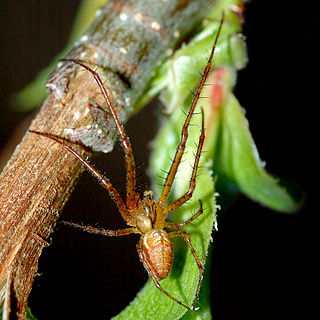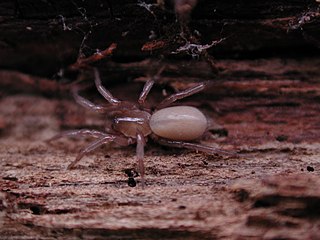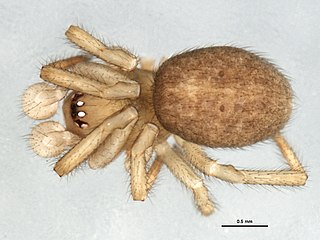
The Agelenidae are a large family of spiders in the suborder Araneomorphae. Well-known examples include the common "grass spiders" of the genus Agelenopsis. Nearly all Agelenidae are harmless to humans, but the bite of the hobo spider may be medically significant, and some evidence suggests it might cause necrotic lesions, but the matter remains subject to debate. The most widely accepted common name for members of the family is funnel weaver.

Long-jawed orb weavers or long jawed spiders (Tetragnathidae) are a family of araneomorph spiders first described by Anton Menge in 1866. They have elongated bodies, legs, and chelicerae, and build small orb webs with an open hub with few, wide-set radii and spirals with no signal line or retreat. Some species are often found in long vegetation near water.

Dictynidae is a family of cribellate, hackled band-producing spiders first described by Octavius Pickard-Cambridge in 1871. Most build irregular webs on or near the ground, creating a tangle of silken fibers among several branches or stems of one plant.

Nemesiidae is a family of mygalomorph spiders first described by Eugène Simon in 1889, and raised to family status in 1985. Before becoming its own family, it was considered part of "Dipluridae". The family is sometimes referred to as wishbone spiders due to the shape of their burrows.
Saltonia is a monotypic genus of North American cribellate araneomorph spiders in the family Dictynidae containing the single species, Saltonia incerta. It was first described by R. V. Chamberlin & Wilton Ivie in 1942, and has only been found in United States. Originally placed with the funnel weavers, it was moved to the Dictynidae in 1967.

Cicurina, also called the cave meshweaver, is a genus of dwarf sheet spiders that was first described by Anton Menge in 1871. Originally placed with the funnel weavers, it was moved to the Dictynidae in 1967, then to the Hahniidae in 2017. The name is from the Latin root "cucur-", meaning "to tame".

Agyneta is a genus of dwarf spiders that was first described by J. E. Hull in 1911.

Phrurolithidae is a family of araneomorph spiders, known as guardstone spiders. The family was first described by Nathan Banks in 1892. First included in the Corinnidae as the subfamily Phrurolithinae, later phylogenetic studies justified a separate family.

Robertus is a genus of comb-footed spiders that was first described by Octavius Pickard-Cambridge in 1879. It is considered a senior synonym of Garritus.

Cybaeina is a genus of North American araneomorph spiders in the family Cybaeidae, and was first described by R. V. Chamberlin & Wilton Ivie in 1932. Originally described from a single female found in Olympia, Washington, it was placed with the Cybaeidae in 1967.

Cybaeota is a genus of North American araneomorph spiders in the family Cybaeidae, and was first described by R. V. Chamberlin & Wilton Ivie in 1933. It was moved to the Cybaeidae in 1967.
Cybaeozyga is a monotypic genus of North American araneomorph spiders in the family Cybaeidae containing the single species, Cybaeozyga heterops. It was first described by R. V. Chamberlin & Wilton Ivie in 1937, and was moved to the Cybaeidae in 1967. It has only been found in United States.

Blabomma is a genus of araneomorph spiders in the family Cybaeidae, and was first described by R. V. Chamberlin & Wilton Ivie in 1937. Originally placed with the funnel weavers, it was moved to the Dictynidae in 1967, and to the Cybaeidae in 2017.
Yorima is a genus of araneomorph spiders in the family Cybaeidae and was first described by R. V. Chamberlin & Wilton Ivie in 1942. Originally placed in the funnel weaver family, it was moved to the Dictynidae in 1967, and to the Cybaeidae in 2017.

Calymmaria is a genus of North American araneomorph spiders in the family Cybaeidae, and was first described by R. V. Chamberlin & Wilton Ivie in 1937. They have body lengths ranging from 2 to 10 millimetres.
Dirksia is a genus of araneomorph spiders in the family Cybaeidae, and was first described by R. V. Chamberlin & Wilton Ivie in 1942 as a subgenus of Ethobuella. Originally placed with the funnel weavers, it was elevated to genus and moved to the dwarf sheet spiders in 1967, then moved to the Cybaeidae in 2017. As of May 2019 it contains only two species: D. cinctipes and D. pyrenaea.
Ethobuella is a genus of North American araneomorph spiders in the family Cybaeidae, and was first described by R. V. Chamberlin & Wilton Ivie in 1937. As of May 2019 it contains only two species: E. hespera and E. tuonops. Originally placed with the funnel weavers, it was elevated to genus and moved to the dwarf sheet spiders in 1967, then moved to the Cybaeidae in 2017.

Pityohyphantes, commonly known as hammock spiders, is a genus of sheet weavers that was first described by Eugène Louis Simon in 1929. The name comes from the Ancient Greek Πίτυς (pitys), meaning "pine", and hyphantes, meaning "weaver".














